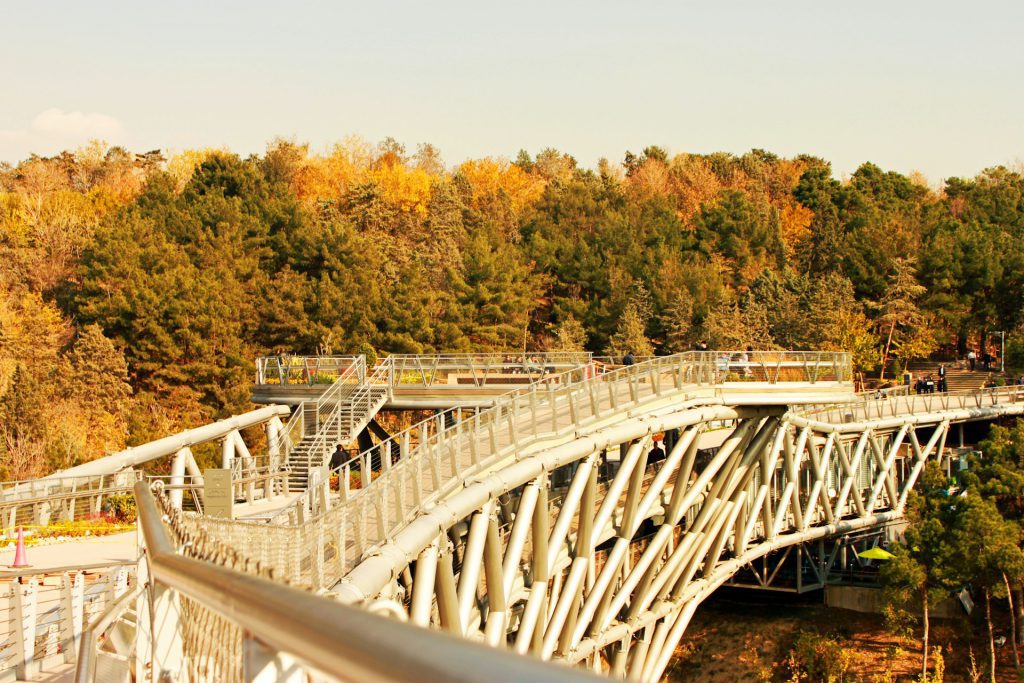Table of Contents
Located in the heart of Tehran, Tabiat Bridge emerges as a striking symbol of modernity and creativity, comparable to the iconic Milad Tower and Azadi Tower. This isn’t just the largest pedestrian bridge in Iran; it serves as a vital connection between two of the city’s most cherished parks, inviting both locals and visitors to immerse themselves in the lush greenery surrounding them. Its architectural elegance captivates the eye, but its deeper significance lies in the vision of its designer, a talented young woman whose work embodies the spirit and resilience of contemporary Iranian women.
Tabiat Bridge goes beyond mere functionality; it stands as a cultural landmark that celebrates the harmony between urban life and nature. As people stroll along its pathways, they not only enjoy breathtaking views but also engage in a shared experience that reflects the rich tapestry of Iranian culture. This bridge is a testament to innovation and connectivity, showcasing how modern design can foster a sense of community and appreciation for the natural world, all while honoring the legacy of those who dare to dream.
History of Tabiat Bridge

Designed by the visionary duo Leila Araghian and Alireza Behzadi, Tabiat Bridge began its construction in 2010 and was completed in 2014. This period was marked by international sanctions against Iran, which led to delays due to the involvement of foreign companies in the project. However, these challenges inadvertently elevated the bridge’s cultural significance. At a time when the world was grappling with division, represented by slogans like “Build a Wall,” Iranians were channeling their creativity and resources into constructing a “Bridge”—a symbol of connection and unity that transcends mere geography.
Araghian’s design philosophy was deeply rooted in her rich cultural heritage. She envisioned the bridge as more than just a means to traverse between parks; it was meant to be a space for reflection and community engagement. As she eloquently stated, “I didn’t want it to be just a bridge which people would use to get from one park to another, I wanted it to be a place for people to stay and ponder, not simply pass.” This intention transformed Tabiat Bridge into a gathering point where individuals can appreciate nature, connect with one another, and celebrate a shared cultural identity—a true testament to the resilience and creativity of those who built it.
Architecture of Tabiat Bridge
Spanning an impressive 270 meters, Tabiat Bridge, also translated as Nature Bridge Tehran, is not just a passageway; it’s an experience designed to encourage visitors to linger and enjoy their surroundings. The architects thoughtfully integrated numerous benches, vibrant gardens, and modern landscapes along the walkway, creating inviting spaces for relaxation and contemplation. With a variety of cafes and restaurants dotting the bridge, guests can savor delicious meals while taking in the stunning nighttime views of the illuminated highway below.
The bridge’s structural design is equally captivating, featuring two piers that rest on stepped foundations. This innovative approach enhances stability while allowing for a unique arch in the walkway that obscures the typical views found on most bridges. This architectural choice fosters a sense of security for those traversing the bridge, inviting them to explore at a leisurely pace rather than simply rushing from one side to the other. Together, these elements not only showcase the ingenuity of the design but also elevate Tabiat Bridge into a realm where architecture meets community and nature.
Tabiat Bridge features a unique three-story design that enhances its functionality and visitor experience. The two main levels are complemented by a third story nestled between the piers, offering a peaceful retreat for those wishing to linger longer. This additional space provides a serene environment, ideal for relaxation or contemplation, while all three levels are seamlessly connected by a series of stairs and sloped paths, encouraging exploration and interaction.
The second story serves as the primary thoroughfare, linking the vibrant parks of Ab-o-Atash and Taleghani, making it the most frequented level. Constructed primarily from steel, the bridge is both robust and resilient, while the walkway is elegantly finished with a layer of Resysta wood. This innovative material mimics the aesthetic of traditional wood tiles but boasts superior strength and durability, ensuring that the bridge can withstand the test of time and the bustling activity of its many visitors. Together, these architectural choices create a dynamic space that invites people to connect with nature and each other.
Ab-o-Atash Park
Ab-o-Atash Park is a vibrant oasis that caters to visitors of all ages, offering a wealth of recreational and entertainment options. Beyond its scenic walking paths, the park features a dedicated cinema hall showcasing films about space and astronomy, alongside a captivating planetarium that sparks curiosity about the cosmos. For community gatherings, the amphitheater, which accommodates up to 370 people, hosts a range of social events, creating a lively hub for cultural and artistic expression.
For those with a penchant for physical activity, the park doesn’t disappoint. It boasts facilities for skateboarding and skating, along with various sports machines and bike paths that encourage an active lifestyle. Equestrian enthusiasts can even find spaces for horse training. To complement these activities, the southern section of the park is home to a bustling food court, offering a diverse selection of cafes and restaurants, perfect for refueling after a day of fun. Ab-o-Atash Park truly embodies a multifaceted environment where nature, culture, and community converge seamlessly.
How to Get to Tabiat Bridge
By Metro
Reaching Tabiat Bridge is a delightful experience, with multiple transport options available to suit your style. If you prefer the metro, make your way to Shahid Haghani station, the closest stop. From there, a leisurely 15-minute stroll through the picturesque Taleghani Park awaits you—this charming walk not only leads you closer to the bridge but also allows you to soak in the park’s serene atmosphere.
By Bus
Alternatively, if you’re coming from the northern parts of Tehran, hop on a bus at the nearby Martyr Haghani terminal. This convenient option ensures you can navigate the city with ease while enjoying the vibrant street life along the way.
By Car
For those who enjoy driving, Tabiat Bridge is accessible via several major highways, including Haghani, Modares, and Hemmat. A spacious parking lot located to the east of Taleghani Park makes it easy to find a spot for your vehicle.
On Foot
If you’re a walking enthusiast, consider starting from Valiasr Street; simply head towards Vanak Square and follow Haghani Highway to reach Ab-o-Atash Park and ultimately Tabiat Bridge. Each route offers its own unique charm and perspective of Tehran, making your journey as enjoyable as the destination itself.
Best Time to Visit Tabiat Bridge

One of the fantastic times to explore Tabiat Bridge is during the Nowruz holiday. This period sees an influx of visitors, creating a vibrant and festive atmosphere. The bridge becomes a social hub where locals and tourists alike gather to take photographs and share stories. Although it can be crowded, this lively environment offers a unique opportunity to engage with the community and experience Tehran’s culture firsthand.
Whether you’re there for a quiet evening or to soak in the festive spirit, this Tehran bridge promises an unforgettable experience at any time of day.
Where to Eat Near Tabiat Bridge
Melal Cafe Restaurant
Just a stone’s throw from Tabiat Bridge, you’ll find a delightful array of dining options that cater to diverse tastes. One standout is Melal Cafe Restaurant, located on the west side of the bridge. Known for its self-service breakfasts, this spot is a favorite among tourists and locals alike. With its glass-walled structure, diners can enjoy stunning views of the surrounding parks while savoring a hearty meal. If you’re in the mood for something more casual, VIP Cafe awaits you on the lower level of the bridge. This charming café offers a fantastic terrace view, making it an ideal place to unwind with a delicious breakfast or a variety of Iranian and international dishes.
Food Court
For those looking for a broader selection, the food court situated in the eastern section of Tabiat Bridge is a must-visit. Here, you’ll find an impressive variety of Iranian and cultural dishes, ensuring there’s something for everyone. The open-air seating allows you to enjoy your meal while taking in the scenic beauty around you. Whether you’re craving traditional Persian cuisine or a quick snack, this vibrant food court provides the perfect backdrop for a delightful dining experience after exploring the bridge and its surroundings.
Where to Stay Near Tabiat Bridge
Laleh Hotel
For those looking to enjoy the vibrant atmosphere around Tabiat Bridge, a variety of accommodation options are available nearby. If luxury is what you seek, consider the Laleh Hotel, which offers top-notch amenities and stunning views of the Alborz Mountains. This hotel not only ensures a lavish experience but also places you within close proximity to the beautiful parks surrounding the bridge, allowing you to explore at your leisure.
Espinas Palace Hotel
Another excellent choice for a luxurious stay is the Espinas Palace Hotel. With its elegant design and exceptional service, guests can indulge in comfort while enjoying easy access to local attractions. The hotel’s facilities cater to both relaxation and entertainment, making it a perfect base for your adventures around Tabiat Bridge.
Parsian Esteghlal Hotel
The Parsian Esteghlal Hotel is also a fantastic option, providing a comfortable stay with breathtaking views. Its strategic location allows guests to easily reach nearby parks and cultural sites, ensuring that your experience in Tehran is both enjoyable and convenient.
Other Attractions Near Tabiat Bridge
Gonbad-e Mina Planetarium
Another notable attraction nearby is the Gonbad-e Mina Planetarium, located just a few steps away. This planetarium offers an engaging experience for those curious about astronomy and the wonders of the universe. Visitors can enjoy captivating shows that take them on a journey through the cosmos, making it a fantastic educational outing for families.
Ports Park and Taleghani Park
Additionally, the Ports Park and Taleghani Park are both within easy reach, providing more opportunities for leisurely walks or picnics amidst lush greenery. Together, these attractions create a vibrant cultural tapestry surrounding Tabiat Bridge, ensuring that your visit is filled with exploration and enjoyment.
FAQs about Tabiat Bridge
Q1: Where is Tabiat Bridge located?
A1: Tabiat Bridge is located in Tehran, Iran, connecting Ab-o-Atash Park and Taleghani Park.
Q2: Who built Tabiat Bridge?
A2: Tabiat Bridge was built by Iranian architects Leila Araghian and Alireza Behzadi.
Q3: What is the purpose of Tabiat Bridge?
A3: The bridge serves as a pedestrian walkway between two parks and a place for relaxation and community engagement.
Q4: How do I get to Tabiat Bridge by car?
A4: You can reach Tabiat Bridge by driving along Haghani, Modares, or Hemmat highways, with parking available east of Taleghani Park.
Q5: What is the best time to visit Tabiat Bridge?
A5: The best time to visit is during Nowruz, but the bridge is enjoyable at any time of the year.
Last Words: Discover the Best of Tabiat Bridge with a Customized Tour
Tabiat Bridge, located in central Tehran, is a modern and creative landmark, similar to the famous Milad and Azadi Towers. As Iran’s largest pedestrian bridge, it connects two popular parks, encouraging both locals and tourists to enjoy the surrounding greenery. This Tehran bridge’s beautiful design is a reflection of its young female designer, symbolizing the strength of contemporary Iranian women. More than just a functional structure, Tabiat Bridge is a cultural symbol that blends city life with nature.
If you’re planning a trip to Iran and want to fully enjoy the beauty of Nature Bridge Tehran, consider joining a Customized tour. To help you make the most of your visit, To Iran Tour offers professional Iran tours and travel packages designed specifically for you. Our team works diligently to create itineraries that reflect your preferences, ensuring that your experience in Iran is unforgettable. We are here to assist you in crafting an amazing adventure.
Whether you’re interested in history, nature, or local cuisine, our customized Iran Tours will provide the perfect blend of activities to suit your desires. Let us help you create memories that will last a lifetime!



